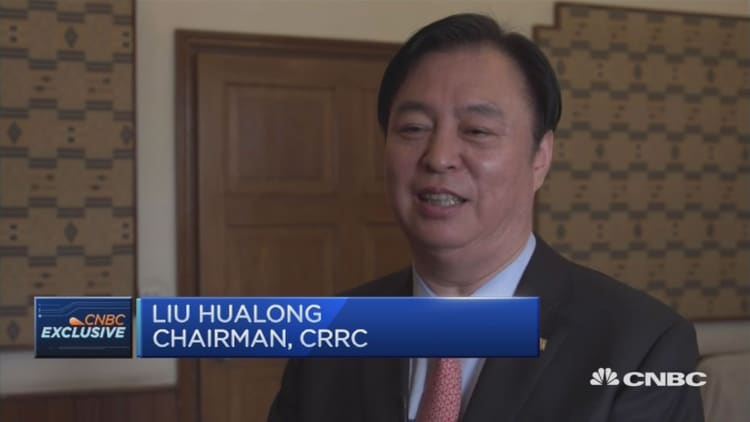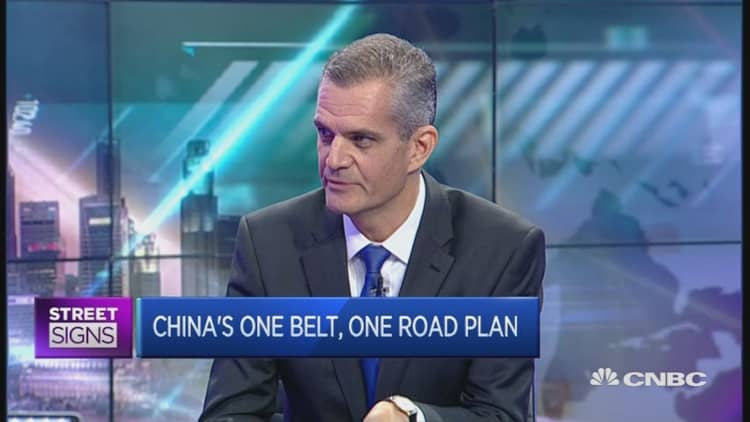
China has rapidly climbed the ranks to become the world's second-largest economy. Now, the most populous nation on the planet wants to increase its influence by digging further into its pockets — flush with cash after decades of rapid growth — to splash out with its "One Belt, One Road" policy.
The initiative is meant to connect Asia, Europe, the Middle East and Africa to bolster trade and development. This weekend, hordes of foreign diplomats and business leaders are expected to descend on Beijing for a two-day meeting about the policy.
Here's what you need to know:
What is "One Belt, One Road?"
President Xi Jinping first announced the policy in 2013; it was later named one of China's three major national strategies, and morphed into an entire chapter in the current five-year plan, to run through 2020.
The plan aims to connect Asia, Europe, the Middle East and Africa with a vast logistics and transport network, using roads, ports, railway tracks, pipelines, airports, transnational electric grids and even fiber optic lines. The scheme involves 65 countries, which together account for one-third of global GDP and 60 percent of the world's population, or 4.5 billion people, according to Oxford Economics.
Why does China want to do this?
This is part of China's push to increase global clout — building modern infrastructure can attract more investment and trade along the "One Belt, One Road" route. It could be beneficial for western China, which is less developed, as it links up with neighboring countries. And in the long run, it will help China shore up access to energy resources.
The policy could boost the domestic economy with demand abroad, and might also soak up some of the overcapacity in China's heavy industry, but analysts say these are fringe benefits.
Experts say China has an opportunity to step into a global leadership role, one that the U.S. previously filled and may now be abandoning, especially after President Donald Trump pulled out of a major trade deal, the Trans-Pacific Partnership.
It's clear China wants to wield greater influence — Xi's speech in January at the World Economic Forum in Davos touted the benefits of globalization, and called for international cooperation. And an article by Premier Li Keqiang published shortly after also called for economic openness.
But despite all the talk of global connectivity, skeptics highlight that China still restricts foreign investment, censorship continues to be an issue and concerns remain over human rights.
How much is China spending?
Most of the funding is coming via China's policy and commercial banks, though there is no official data on OBOR projects and spending estimates vary.
In 2015, the China Development Bank said it had reserved $890 billion for more than 900 projects. The Export-Import Bank of China announced early last year that it had started financing over 1,000 projects. The China-led Asian Infrastructure Investment Bank is also providing financing.
China's big four state-owned banks are estimated to have extended $90 billion in loans to OBOR countries in 2016, according to analysis by Oxford Economics. And Credit Suisse estimates China could invest as much as $500 billion in about 60 countries over the next five years.
The assumption is that these countries will be able to pay China back, and that lenders will know how to manage credit risk. This means the obvious challenge is that if these projects fail to deliver as expected, bad debts could create a strain. But the leaks may not spring for a while, as infrastructure projects tend to have a long lead time.
What OBOR projects have already launched?
Plenty have launched thus far, including a 418-kilometer rail link with Laos, and a collection of infrastructure projects totaling $46 billion, named the China-Pakistan Economic Corridor. A freight train service is linking China and Europe. And China and France are jointly developing the $24 billion Hinkley Point nuclear power plant in the U.K.
In reality, however, reports abound of delays and confusion. There are worries over due diligence — making sure the money is being well-spent — which is tough to track in other countries and remains a potent domestic challenge despite China's anti-corruption crackdown.

Wait, wasn't China already heavily investing abroad?
China's state-owned enterprises and private companies have long invested abroad. In some ways, experts at research firm IHS say the OBOR initiative is simply smart branding for what China was already doing. At the same time, this is Beijing using its political might — China announcing with a bullhorn its support for investment abroad could help grease the wheels to get deals and contracts through faster.
Who benefits?
Much of the projects heavily involve China's state-owned enterprises, from oil & gas companies to railway construction — think oil firm Sinopec, rail car manufacturer CRRC and utilities like State Grid. Analysts say foreign construction machinery companies are also poised to benefit.
Other major foreign companies including General Electric and Siemens have made clear they're targeting participation in OBOR projects.
In the long run, "OBOR could boost internationalization of the renminbi by encouraging its use in both trade and financial transactions," wrote Tianjie He of Oxford Economics.


